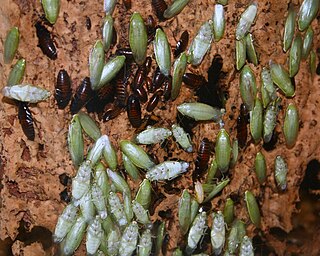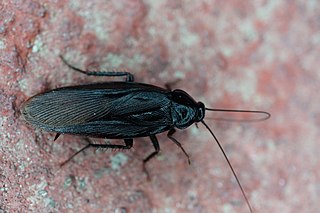
An instar is a developmental stage of arthropods, such as insects, between each moult (ecdysis), until sexual maturity is reached. Arthropods must shed the exoskeleton in order to grow or assume a new form. Differences between instars can often be seen in altered body proportions, colors, patterns, changes in the number of body segments or head width. After shedding their exoskeleton (moulting), the juvenile arthropods continue in their life cycle until they either pupate or moult again. The instar period of growth is fixed; however, in some insects, like the salvinia stem-borer moth, the number of instars depends on early larval nutrition. Some arthropods can continue to moult after sexual maturity, but the stages between these subsequent moults are generally not called instars.

The American cockroach is the largest species of common cockroach, and often considered a pest. In certain regions of the U.S. it is colloquially known as the waterbug, though it is not a true waterbug since it is not aquatic. It is also known as the ship cockroach, kakerlac, and Bombay canary. It is often misidentified as a palmetto bug.

The Florida woods cockroach or palmetto bug is a large cockroach species which typically grows to a length of 30–40 mm (1.2–1.6 in). When alarmed, adults can eject an extremely foul-smelling directional spray up to 1 m, which inspired several of its other common names: Florida skunk roach, Florida stinkroach, skunk cockroach, skunk roach, stinking cockroach, and stinkroach. Two other naming variations include Florida cockroach and Florida woods roach.

The oriental cockroach, also known as the waterbug or black cockroaches, is a large species of cockroach, adult males being 18–29 mm (0.71–1.14 in) and adult females being 20–27 mm (0.79–1.06 in). It is dark brown or black in color and has a glossy body. The female has a somewhat different appearance from the male, appearing to be wingless at a casual glance, but is brachypterous, having non-functional wings just below her head. She has a wider body than the male. The male has long wings, which cover three quarters of the abdomen and are brown in color, and has a narrower body. Both of them are flightless. The female oriental cockroach looks somewhat similar to the Florida woods cockroach and may be mistaken for it. Originally endemic to the Crimean Peninsula and the region around the Black Sea and the Caspian Sea, its distribution is now cosmopolitan.

The Asian cockroach, is a species of cockroach that was first described in 1981 from insects collected on Okinawa Island, Japan. It is a small species of cockroach, typically 1.3 to 1.6 centimetres long and tan to dark brown in colour with dark parallel stripes on the back of their heads. It is commonly mistaken with the German cockroach for their similar appearance. It is commonly found in the United States in and around houses.

Panchlora nivea, the Cuban cockroach or green banana cockroach, is a small species of cockroach found in Cuba and the Caribbean, and along the Gulf Coast from Florida to Texas, and has been observed as far north as Moncks Corner, South Carolina. It is found in subtropical or tropical climates.

The smokybrown cockroach is a large species of cockroach, winged, and growing to a length of 32–35 millimetres (1.3–1.4 in).

Parcoblatta virginica, the Virginia wood cockroach, is a small cockroach species of the genus Parcoblatta, measuring about a centimeter long as an adult.

Blattodea is an order of insects that contains cockroaches and termites. Formerly, termites were considered a separate order, Isoptera, but genetic and molecular evidence suggests they evolved from within the cockroach lineage, cladistically making them cockroaches as well. The Blattodea and the mantis are now all considered part of the superorder Dictyoptera. Blattodea includes approximately 4,400 species of cockroach in almost 500 genera, and about 3,000 species of termite in around 300 genera.

Cockroaches are insects belonging to the order Blattaria. About 30 cockroach species out of 4,600 are associated with human habitats. Some species are well-known as pests.

The death's head cockroach is a species of cockroach belonging to the family Blaberidae. It is often confused with the discoid cockroach, Blaberus discoidalis, due to its similar appearance. It is distinguished by jet black cloak-like marking on its wings and a skull-shaped, amber/black marking on its pronotum. The name death's head comes from the markings on the top of the pronotum: "cranii", which is Latin for "of the head", and "fer", meaning "carry" or "carrier". Due to their unique appearance and certain characteristics, they make an easy to care for pet or display insect for entomologists and hobbyists.

Blaberus giganteus, the Central American giant cave cockroach or Brazilian cockroach, is a cockroach belonging to the family Blaberidae. One of the world's largest cockroaches, it is native to the warm parts of the Neotropical realm.

Blaptica dubia, the Dubia roach, orange-spotted roach, Guyana spotted roach, or Argentinian wood roach, is a medium-sized species of cockroach which grows to around 40–45 mm (1.6–1.8 in).

Evania appendigaster, also known as the blue-eyed ensign wasp, is a species of wasp in the family Evaniidae. Its native range is not known, but it likely originated in Asia. Today it occurs throughout the tropics and subtropics and in many temperate regions. As with the rest of its family, the blue-eyed ensign wasp is a parasitoid known for specializing on cockroach eggs.

The Japanese cockroach, also known as the Yamato cockroach, is a cockroach native to Japan, adapted to cooler northern climates. It has a flexible univoltine or semivoltine lifecycle, depending on the timing of its hatching, and is unusual in being able to spend two winters as diapause nymphs before reaching maturity.

Eublaberus distanti, known as the six-spotted, four-spotted, four-spot, or Trinidad bat-cave roach or cockroach, is a primarily cave-dwelling Central and South American cockroach of the genus Eublaberus.

Cariblatta lutea is a small species of cockroach native to the United States and other countries, measuring usually around 7 millimeters long as an adult and under 2 millimeters from head tip to abdomen tip at the 1st instar or hatchling. It consists of two subspecies, the small yellow cockroach, and the least yellow cockroach.

Parcoblatta uhleriana, the Uhler's wood cockroach, is a species of Parcoblatta native to the United States and Canada. It is a forest species also found in disturbed and urban environments. The male of the species flies freely, while the female does not fly.

Neostylopyga is a genus of cockroaches described by Robert Walter Campbell Shelford in 1911. Some of the species are strikingly coloured and patterned and are popular in cultures under the common name harlequin roaches or harlequin cockroaches.



























